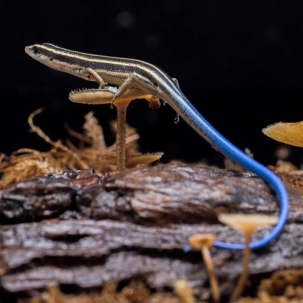Are Skinks Venomous?
No, skinks are not venomous. These lizards do not produce or inject venom. Skinks rely on speed and agility—not venom—for self-defense. Their bite, while potentially startling, is harmless aside from minor skin irritation or a small pinch if they feel threatened or handled roughly:
Venom glands: Skinks have no venom glands or specialized teeth for delivering toxins.
Saliva: Their saliva is non-toxic and does not contain harmful bacteria like those found in some reptiles (e.g., Komodo dragons).
Skinks are completely non-venomous and low-risk reptiles. They’re actually beneficial around homes and gardens since they help control insect populations.
Are Skinks Poisonous?
Skinks are not typically considered to be poisonous in the sense that they produce toxins harmful to humans or other animals through their bites, stings, or skin secretions. However, there are a few exceptions where certain species of skinks possess glands or adaptations that can be considered mildly toxic or irritating in some way. These cases are relatively rare compared to other poisonous animals like some frogs, snakes, or insects. Here are a couple of examples:
- Blue-Tailed Skink (Plestiodon skiltonianus): This North American skink species is not poisonous but can secrete a foul-smelling substance from its cloacal glands when threatened. While not harmful to humans, this secretion can be unpleasant.
- Fire Skink (Lepidothyris fernandi): The Fire Skink, native to West Africa, is sometimes said to have mildly toxic skin secretions. These secretions are thought to deter predators, but they are not known to be seriously harmful to humans. However, it's essential to handle these lizards with care and wash your hands thoroughly after handling them.
Skinks come in a wide variety of species, and some may exhibit unique adaptations or behaviors. While most skinks are harmless to humans and other animals, it's essential to remember that there may be exceptions, and some species could carry diseases or parasites. Therefore, it's generally advisable to handle any wild animal, including skinks, with caution and avoid unnecessary contact.
In general, the term "poisonous" is not commonly associated with skinks, and their primary defense mechanisms involve tactics such as tail autotomy (shedding) and camouflage. The toxicity levels, if present in certain species, are typically not a significant concern for human health. Nonetheless, it's advisable to treat all wild animals with caution and avoid unnecessary contact, as reactions to substances produced by animals can vary from person to person.
One common defense mechanism among skinks is their ability to shed their tails when threatened. This behavior, known as autotomy, allows them to escape from a predator while the detached tail continues to wriggle, distracting the attacker. The lost tail can later regenerate, although the regenerated tail is often not as long or well-formed as the original.
Skink Poison
While skinks are not generally considered highly venomous or dangerous to humans, some species have developed specialized skin secretions that can be mildly irritating or toxic to potential predators. These secretions serve as a defense mechanism to deter predators and are often produced in specialized glands, such as cloacal or scent glands. Here's some more information about the potentially toxic skin secretions of skinks:
- Foul Odor: Many skinks have glands near their cloaca (the opening used for waste elimination and reproduction) that can emit foul-smelling substances when they feel threatened. The odor is intended to deter predators by making the skink seem unappetizing or even repulsive. This defense mechanism is more about discouraging potential threats than causing harm.
- Irritating Substances: In some cases, the skin secretions of certain skink species can contain mildly irritating substances. These substances are not typically harmful to humans but can cause discomfort if they come into contact with the eyes, nose, or mouth. The irritation is often temporary and relatively mild.
- Fire Skink (Lepidothyris fernandi): The Fire Skink, native to West Africa, is an example of a skink species that is sometimes said to have mildly toxic skin secretions. While these secretions are not known to cause significant harm to humans, they are thought to be a deterrent to potential predators.
The toxicity of skink secretions varies between species, and the effects on humans are generally minimal. Additionally, the primary purpose of these secretions is to discourage predation by other animals rather than causing harm to humans. Nevertheless, it's wise to handle all wildlife, including skinks, with care and to wash your hands thoroughly after any contact to avoid any potential irritation or allergic reactions.
Are Skinks Dangerous?
Skinks are generally harmless to humans, but there are a few ways in which they might be considered dangerous, depending on the context:
Potential for Bites (Rare and Mild)
- Skinks are not aggressive and rarely bite, but if they feel threatened, they may attempt to defend themselves.
- Skink bites are not venomous and typically do not cause serious harm beyond minor irritation.
Salmonella Risk
- Like many reptiles, skinks can carry Salmonella bacteria in their digestive tract.
- Handling a skink and then touching food or one’s face without washing hands could lead to an infection.
Toxicity to Pets
- Some skink species, such as blue-tailed skinks, are believed to be mildly toxic to cats and dogs if ingested.
- Reports suggest that pets that eat skinks may experience symptoms such as vomiting, lethargy, or neurological issues, though scientific evidence is limited.
Mistaken Identity with Venomous Snakes
- Some skinks have elongated bodies and smooth, shiny scales that may resemble small snakes, causing unnecessary panic.
- In areas where venomous snakes are common, a misidentification could lead to overreaction or fear.
Crop and Garden Impact
- While skinks are beneficial in controlling insect populations, they may occasionally feed on small fruits, seeds, or beneficial garden insects.
Overall, skinks are not inherently dangerous and are more beneficial than harmful, as they help control pest populations. However, proper hygiene and supervision of pets can help mitigate any minor risks they may pose.

